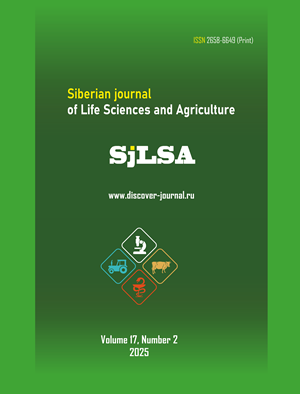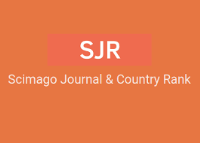Analysis of gene expression changes in canola in response to inoculation with biotic and abiotic elicitors to Alternaria brassicae
Аннотация
Background. Alternaria brassicae is one of the most destructive pathogens of oilseed rape growth and production. Oilseed rape roots treated with biotic and abiotic elicitors have shown resistance to A. brassicae as a result of induced systemic resistance (ISR). In this experiment, we aimed to identify resistance genes in two rapeseed genotypes (Raphanus brassica and Brassica napus).
Methods. Pseudomonas fluorescens PF83 as a biotic elicitor and with Salicylic acid (SA) as an abiotic elicitors were used induced systemic resistance in rapeseed. The expression levels of six defense-related genes (VSP2, MYC2, PR-2, PR-3, PR-4 and PR-5) by Quantitative real-time PCR (qRT-PCR) at three times 24, 48 and 120 hpi.
Results. VSP2, MYC2, PR-3 and PR-4 gene expression levels increased in infected leaves by A. brassicae and in oilseed genotypes treated by PF83, while the expression levels of PR-2 and PR-5 were increased in leaves treated with SA. The results indicate that the induction of resistance genes depends on the type of elicitor, the biotic and abiotic elicitors interferes with phytohormones SA- and JA-pathways to A. brassicae, through the increase in the transcription of resistance-related genes. The abiotic elicitor is key to inducing resistance genes associated with SA-pathways, while the biotic elicitor is key to inducing resistance genes associated with JA-pathways. The results of our study provide a new understanding of the control mechanisms of A. brassica.
Conclusion. This study provides a new understanding of the control mechanisms of A. brassica. The abiotic elicitor is key to inducing resistance genes associated with SA-pathways, while the biotic elicitor is key to inducing resistance genes associated with JA-pathways. This study explained, that the RR genome is responsible for disease resistance in oilseed R. brassica (AARR) to infection processes of A. brassicae, so we recommend that using R. brassica as resistance genotype to produce oilseed.
EDN: PTWHNI
Скачивания
Литература
Borges, C. E., Von dos Santos Veloso, R., da Conceição, C. A., Mendes, D. S., Ramirez-Cabral, N. Y. Z., Shabani, F., Shafapourtehrany, M., Nery, M. C., & da Silva, R. S. (2023). Forecasting Brassica napus production under climate change with a mechanistic species distribution model. Sci Rep, 13, 12656. https://doi.org/10.1038/s41598-023-38910-3. EDN: https://elibrary.ru/DHJJCL
Lu, K., Wei, L., Li, X., et al. (2019). Whole-genome resequencing reveals Brassica napus origin and genetic loci involved in its improvement. Nature Communications, 10, 1154. https://doi.org/10.1038/s41467-019-09134-9. EDN: https://elibrary.ru/ISGZFQ
Lange, W. H., Toxopeus, J. H., Lubberts, Dolstra, O., & Harrewijn, J. L. (1989). The development of raparadish Brassica raphanus 2n equals 38, a new crop in Agriculture. Euphytica, 40, 1-14.
Mandal, S., Rajarammohan, S., & Kaur, J. (2018). Alternaria brassicae interactions with the model Brassicaceae member Arabidopsis thaliana closely resembles those with Mustard (Brassica juncea). Physiol Mol Biol Plants, 24(1), 51-59. https://doi.org/10.1007/s12298-017-0486-z
Alkooranee, J. T., Yin, Y., Aledan, T. R., Jiang, Y., Lu, G., Wu, J., & Li, M. (2015). Systemic Resistance to Powdery Mildew in Brassica napus (AACC) and Raphanus alboglabra (RRCC) by Trichoderma harzianum TH12. PLoS ONE, 10(11). https://doi.org/10.1371/journal.pone.0142177
Salwan, R., Sharma, M., Sharma, A., & Sharma, V. (2023). Insights into plant beneficial microorganism-triggered induced systemic resistance. Plant Stress, 7, 100140. https://doi.org/10.1016/j.stress.2023.100140. EDN: https://elibrary.ru/BALPVT
Vicente, M., & Plasencia, J. (2011). Salicylic acid beyond defence: its role in plant growth and development. Journal of Experimental Botany, 1-18.
Khoso, M. A., Wagan, S., Alam, I., Hussain, A., Ali, Q., Saha, S., Poudel, T. R., Manghwar, H., & Liu, F. (2024). Impact of plant growth-promoting rhizobacteria (PGPR) on plant nutrition and root characteristics: Current perspective. Plant Stress, 11, 100341. https://doi.org/10.1016/j.stress.2023.100341. EDN: https://elibrary.ru/HMMVHH
Astapati, A. D., & Nath, S. (2023). The complex interplay between plant-microbe and virus interactions in sustainable agriculture: Harnessing phytomicrobiomes for enhanced soil health, designer plants, resource use efficiency, and food security. Crop Design, 2, 100028. https://doi.org/10.1016/j.cropd.2023.100028. EDN: https://elibrary.ru/XJUXCS
Cordero, A. P., Vergara, D. E. M., & Mendoza, Y. A. (2023). Production of 1-aminocyclopropane-1-carboxylic acid deaminase (ACC) by Burkholderia cepacia as an indicator of cadmium contamination. J. Posit. Sch. Psychol, 7(1), 1008-1016.
Leeman, M., Van Pelt, J. A., Hendrickx, M. J., Scheffer, R. J., Bakker, P. A. H. M., & Schippers, B. (1995). Biocontrol of Fusarium wilt of radish in commercial greenhouse trials by seed treatment with P. fluorescens WCS374. Phytopathology, 85, 1301-1305. https://doi.org/10.1094/Phyto-85-1301
Nandakumar, R., Babu, S., Viswanathan, R., Raguchander, T., & Samiyappan, R. (2001). Induction of systemic resistance in rice against sheath blight disease by Pseudomonas fluorescens. Soil Biology and Biochemistry, 33(4-5), 603-612. https://doi.org/10.1016/S0038-0717(00)00202-9. EDN: https://elibrary.ru/ZBAFOP
Anand, T., Chandrasekaran, A., Kuttalam, S., Raguchander, T., Prakasam, V., & Samiyappan, R. (2007). Association of some plant defense enzyme activities with systemic resistance to early leaf blight and leaf spot induced in tomato plants by azoxystrobin and Pseudomonas fluorescens. Journal of Plant Interactions, 2(4), 233-244. https://doi.org/10.1080/17429140701708985
Bas, W. M. V., Trotel-Aziz, P., Couderchet, M., Höfte, M., & Aziz, A. (2010). Pseudomonas spp.-induced systemic resistance to Botrytis cinerea is associated with induction and priming of defence responses in grapevine. Journal of Experimental Botany, 61(1), 249-260. https://doi.org/10.1093/jxb/erp295. EDN: https://elibrary.ru/NZOCVJ
Weller, D. M., Mavrodi, D. V., van Pelt, J. A., Pieterse, C. M., van Loon, L. C., & Bakker, P. A. (2012). Induced systemic resistance in Arabidopsis thaliana against Pseudomonas syringae pv. tomato by 2,4-diacetylphloroglucinol-producing Pseudomonas fluorescens. Phytopathology, 102(4), 403-412. PMID: 22409433. https://doi.org/10.1094/PHYTO-08-11-0222
Madhavi, G. B., Devi, G. U., Kumar, K. V. K., Babu, T. R., & Naidu, T. C. M. (2018). Evaluation of Pseudomonas fluorescens and Trichoderma harzianum isolates in inducing systemic resistance (ISR) in maize against Rhizoctonia solani f. sp. Sasakii. International Journal of Chemical Studies, 6(2), 628-632.
King, E. O., Word, M. K., & Raney, D. E. (1954). To simple media for the demonstration of pyocyamin and fluorescin. J. Lab. Clin. Med., 414, 301-307.
Gomez, K. A., & Gomez, A. A. (1984). Statistical procedures for agricultural research. John Wiley and sons, Inc., London, UK (2nd ed.), pp. 13-175.
Ross, A. F. (1961). Systemic acquired resistance induced by localized virus infections in plants. Virology, 14, 340-358. https://doi.org/10.1016/0042-6822(61)90319-1
Terras, F. R. G., Schoofs, H. M. E., & De Bolle, M. F. C. (1992). Analysis of two novel classes of plant antifungal proteins from radish (Raphanus sativus L.) seeds. J Biol Chem, 267, 15301-15309. https://doi.org/10.1016/S0021-9258(19)49534-3
De Samblanx, G. W., Goderis, I. J., Thevissen, K., Raemaekers, R., Fant, F., Borremans, F., Acland, D. P., Osborn, R. W., Patel, S., & Broekaert, W. F. (1997). Mutational Analysis of a Plant Defensin from Radish (Raphanus sativus L.) Reveals Two Adjacent Sites Important for Antifungal Activity. The journal of Biological Chemistry, 272(2), 1171-1179. https://doi.org/10.1074/jbc.272.2.1171
Pudjiraharti, S., & Karossi, A. T. A. (2009). Purification and characterization of white radish (Raphanus sativus L. var Long White) peroxidase from culture extract. Teknologi Indonesia, 32(2), 91-98.
Alkooranee, J. T., Aledan, T. R., Ali, A. K., Lu, G., Zhang, X., Wu, J., Fu, C., & Li, M. (2017). Detecting the Hormonal Pathways in Oilseed Rape behind Induced Systemic Resistance by Trichoderma harzianum TH12 to Sclerotinia sclerotiorum. PLoS ONE, 12(1), e0168850. https://doi.org/10.1371/journal.pone.0168850. EDN: https://elibrary.ru/YXMKMN
Mercado-Blanco, J., van der Drift, K. M. G. M., Olsson, P. E., Thomas-Oates, J. E., van Loon, L. C., & Bakker, P. A. H. M. (2001). Analysis of the pmsCEAB gene cluster involved in biosynthesis of salicylic acid and the siderophore pseudomonine in the biocontrol strain Pseudomonas fluorescens WCS374. J. Bacteriol, 183(6), 1909-1920. https://doi.org/10.1128/JB.183.6.1909-1920.2001
Verhagen, B. W., Trotel-Aziz, P., Couderchet, M., Höfte, M., & Aziz, A. (2010). Pseudomonas spp.-induced systemic resistance to Botrytis cinerea is associated with induction and priming of defence responses in grapevine. J Exp Bot, 61(1), 249-260. https://doi.org/10.1093/jxb/erp295. EDN: https://elibrary.ru/NZOCVJ
Kloepper, J. W., Ryu, C. M., & Zhang, S. (2004). Induced systemic resistance and promotion of plant growth by Bacillus spp. Phytopathology, 94, 1259-1266. https://doi.org/10.1094/PHYTO.2004.94.11.1259
Leon-Reyes, A., Van der Does, D., De Lange, E. S., Delker, C., Wasternack, C., Van Wees, S. C., Ritsema, T., & Pieterse, C. M. (2010). Salicylate-mediated suppression of jasmonate-responsive gene expression in Arabidopsis is targeted downstream of the jasmonate biosynthesis pathway. Planta, 232, 1423-1432. https://doi.org/10.1007/s00425-010-1265-z. EDN: https://elibrary.ru/DCNCRT
Niu, D. D., Liu, H. X., Jiang, C. H., Wang, Y. P., Wang, Q. Y., Jin, H. L., & Guo, J. H. (2011). The plant growth-promoting rhizobacteria Bacillus cereus AR156 induces systemic resistance in Arabidopsis thaliana by simultaneously activating salicylate and jasmonate/ethylene-dependent signalling pathways. Mol Plant Microbe Interact, 24, 533-542. https://doi.org/10.1094/MPMI-09-10-0213
Chitra, K., Ragupathi, N., Dhanalakshmi, K., Mareeshwari, P., Indra, N., Kamalakannan, A., Sankaralingam, A., & Rabindran, R. (2008). Salicylic acid induced systemic resistance on peanut against Alternaria alternata. Archives of Phytopathology and Plant Protection, 41(1), 50-56.
Sangha, M. K., Atwal, A. K., Sandhu, P. S., Bal, R. S., & Banga, S. S. (2007). Salicylic acid induces resistance to Alternaria blight in crop Brassica species. Plant protection: Diseases, 137.
Molinari, S., Fanelli, E., & Leonetti, P. (2014). Expression of tomato salicylic acid (SA)-responsive pathogenesis-related genes in Mi-1-mediated and SA-induced resistance to root-knot nematodes. Mol Plant Pathol, 15(3), 255-264. https://doi.org/10.1111/mpp.12085. EDN: https://elibrary.ru/WQZBLT
Просмотров аннотации: 158
Copyright (c) 2025 J. T. Alkooranee

Это произведение доступно по лицензии Creative Commons «Attribution-NonCommercial-NoDerivatives» («Атрибуция — Некоммерческое использование — Без производных произведений») 4.0 Всемирная.

























































